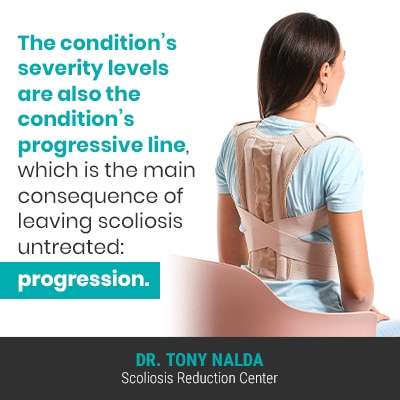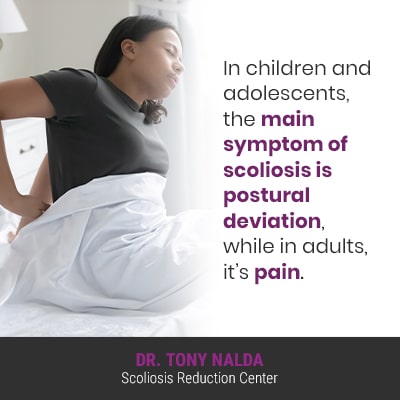Although scoliosis is progressive and incurable, it is highly treatable, especially if diagnosed early and responded to with proactive treatment. If scoliosis is left untreated, it’s virtually guaranteed to get worse at some point, and this means its main symptoms are also likely to become more noticeable: postural deviation and pain.
Scoliosis is a structural spinal condition that has it in its nature to worsen over time, particularly if left untreated. As the unnatural sideways spinal curve progresses, it’s getting larger, and the uneven forces introduced to the body are also increasing, as are condition effects.
Let’s start our exploration of the condition’s long-term effects by first explaining what’s happening inside the body of someone recently diagnosed with scoliosis.
What it Means to Have Scoliosis
The spine’s natural and healthy curves make it stronger, more flexible, and better able to absorb stress incurred during activity; if the spine loses one or more of its healthy curves, its overall health, function, and biomechanics are disrupted.
What it means to have scoliosis is that an unnatural lateral (side-to-side) spinal curvature has developed, with rotation, and it’s the rotational component that makes scoliosis a 3-dimensional condition.
In addition, in order to be diagnosed as scoliosis, the unnatural spinal curve has to be of a minimum size: Cobb angle of 10 degrees.
A patient’s Cobb angle is a key piece of information because it tells me how far out of alignment their spine is and classifies conditions based on severity:
- Mild scoliosis: Cobb angle of between 10 and 25 degrees
- Moderate scoliosis: Cobb angle of between 25 and 40 degrees
- Severe scoliosis: Cobb angle of 40+ degrees
- Very-severe scoliosis: Cobb angle of 80+ degrees

The condition’s severity levels are also the condition’s progressive line, which is the main consequence of leaving scoliosis untreated: progression.
Scoliosis is Progressive
The most dangerous thing about leaving scoliosis untreated is that as a progressive condition, it has it in its nature to worsen over time, so where a scoliosis is at the time of diagnosis doesn’t mean that’s where it will stay without treatment.
Even scoliosis diagnosed as mild can easily progress to moderate, severe, or very severe; only proactive treatment can work towards counteracting the condition’s progressive nature.
The condition progressing means the size of the unnatural spinal curve is going to increase, along with its rotational component, and what an unnatural spinal curve does is introduce a lot of uneven forces to the body, so if a condition is worsening, those forces are also increasing, along with their effects.
The thing about scoliosis is that as a structural incurable spinal condition, once diagnosed, it’s with a person for life, which can sound bleak, but the condition is highly treatable and people are more than capable of thriving with the condition, if treated proactively.
Before getting to the power of proactive treatment, let’s first address some common condition effects: symptoms that tend to escalate along with progression.
What are the Short Term Effects of Scoliosis?
The short-term effects of scoliosis is somewhat of a misnomer; the effects of scoliosis aren’t short term, as it’s a permanent and progressive condition, so let’s focus more on the condition’s telltale signs, such as its earliest condition indicators.
Knowing the condition’s early indicators to watch out for can help lead to early detection, and while there are never treatment guarantees, when a condition is diagnosed early and responded to proactively, there are fewer limits to what can be achieved treatment-wise.
As scoliosis progresses, the spine becomes more rigid, making it less responsive to treatment; in fact, in some of my adult patients who have experienced significant progression prior to starting treatment, preparatory work has to be done before starting the regular course of treatment, to establish a baseline level of spinal flexibility so certain chiropractic adjustments and scoliosis-specific exercises can even be performed.
As you likely recall, scoliosis ranges widely in severity from mild to moderate and severe to very severe, so condition effects will also range widely, and in addition, there are also multiple different types of scoliosis, determined by causation.
The condition’s most-prevalent form is adolescent idiopathic scoliosis (AIS), diagnosed between the ages of 10 and 18, so for our current purposes, we’ll focus on the effects of AIS and scoliosis in adults.

In children and adolescents, the main symptom of scoliosis is postural deviation, while in adults, it’s pain.
Postural Changes
The uneven forces of a scoliotic curve can disrupt the body’s overall symmetry, and in children and adolescents, the condition’s earliest effects are often uneven shoulders and hips.
In addition, the following postural changes are also associated with scoliosis:
- Uneven shoulder blades
- The development of a rib arch
- An uneven waistline
- Arms and legs that appear to hang at different lengths
These types of changes can also disrupt a person’s gait, balance, and coordination, but the thing to understand about scoliosis is that oftentimes, the condition goes unnoticed for long periods of time, especially when mild, and doesn’t get diagnosed until it has progressed into the moderate level, when signs and symptoms tend to become more noticeable.
While adults with scoliosis can also experience the effect of postural changes and developing a prominent lean to one side, the main condition effect is pain.
Pain
While no one wants to experience pain, it does serve a vital purpose: it tells us something is wrong with the body.
When it comes to scoliosis pain, the condition doesn’t become compressive until skeletal maturity has been reached, and it’s compression of the spine and its surrounding muscles and nerves that causes the majority of condition-related pain.
In young patients who are still growing, the spine is experiencing a constant lengthening motion that counteracts the condition’s compressive force, but in adults who are no longer growing, the condition’s most noticeable effect is pain.
It’s pain that brings the vast majority of adults in to see me for a diagnosis and treatment, and oftentimes, it’s pain that radiates into the hands and feet, caused by nerve compression, that leads to a diagnosis of scoliosis in adults.
Not that there really are short-term effects of scoliosis, as in effects that can go away, but let’s now move on to some of the condition’s long-term effects.
What are the Long Term Effects of Scoliosis?
When talking about the long-term effects of scoliosis, we’re talking about progression, and when it comes to the difference between adolescents and adults, growth is a big factor.
The main trigger for progression is growth and development, so children and adolescents are at risk for rapid-phase progression due to the constand trigger of growth, and in adults, the rate of progression tends to slow down because growth is no longer occurring; however, in adults, natural age-related spinal degeneration factors can increase the rate of progression.
While postural deviation will increase with progression, so too will the condition’s other effects such as back and radicular pain (more common in adults), postural changes that involve a disruption to the body’s overall symmetry, and if left untreated, complications are more likely to develop.
If left untreated, the chances of a person’s scoliosis becoming severe and very severe increase, and complications such as digestive issues, lung impairment, and headaches and migraines can develop.
The bottom line is when it comes to the effects of scoliosis, both short and long term, each patient’s case is unique, and how a patient responds with treatment will either maximize, or minimize, potential condition effects.
Conclusion
When a person is diagnosed with scoliosis, the most important decision is how to treat it moving forward, and this is because as a progressive condition, it’s virtually guaranteed to get worse over time, and also because different treatment approaches offer patients different potential outcomes.
The two main scoliosis treatment approaches to choose between are traditional and conservative.
The traditional approach to scoliosis treatment doesn’t respond proactively, and instead watches and waits until a condition progresses into the severe level, when patients become surgical candidates.
Spinal fusion is a costly and invasive procedure that can cost the spine in terms of its overall spinal health, function, and range of motion and flexibility.
A proactive conservative treatment response believes in starting treatment as close to the time of diagnosis as possible in an effort to prevent increasing condition severity, escalating symptoms, and the need for invasive surgical treatment in the future.
Here at the Scoliosis Reduction Center®, I treat patients with a proactive conservative chiropractic-centered treatment approach that centers around minimizing the conditions short- and long-term effects.
Through combining different treatment disciplines, postural changes can be reduced as the unnatural spinal curve is, corrective bracing can help augment corrective results, and physical therapy can help with increasing core strength so the spine can be optimally supported by its surrounding muscles.
Regardless of where a scoliosis is at the time of diagnosis, the best time to start treatment is always now because if left untreated, scoliosis progression makes the condition more complex to treat, so why not start treatment when it’s most likely to be successful?
For those recently diagnosed, don’t hesitate to reach out for guidance and support; it can mean the difference between allowing a condition to progress unimpeded and applying proactive treatment that uses prevention to minimize condition effects.




